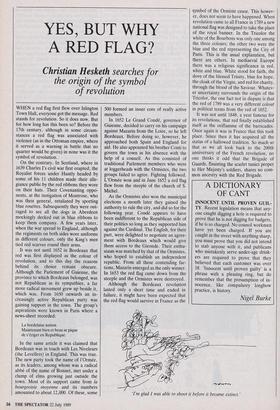YES, BUT WHY A RED FLAG?
Christian Hesketh searches for
the origin of the symbol of revolution
WHEN a red flag first flew over Islington Town Hall, everyone got the message. Red stands for revolution. So it does now. But for how long has this been so? Before the 17th century, although in some circum- stances a red flag was associated with violence (as in the Ottoman empire, where it served as a warning in battle that no quarter would be given) in none was it the symbol of revolution.
On the contrary. In Scotland, where in 1639 Charles I's civil war first erupted, the Royalist forces under Huntly headed by some of his 11 children made their alle- giance public by the red ribbons they wore on their hats. Their Covenanting oppo- nents, at the instigation of Montrose, who was their general, retaliated by sporting blue rosettes. Subsequently they were out- raged to see all the dogs in Aberdeen mockingly decked out in blue ribbons to keep them company. A few years later, when the war spread to England, although the regiments on both sides wore uniforms in different colours, only the King's men tied red scarves round their arms.
It was not until 1652 in Bordeaux that red was first displayed as the colour of revolution, and to this day the reasons behind its choice remain obscure. Although the Parlement of Guienne, the province to which Bordeaux belonged, was not Republican in its sympathies, a far more radical movement grew up beside it, which was. From 1650 onwards an in- creasingly active Republican party was gaining support in the town. The group's aspirations were known in Paris where a news-sheet recorded:
La bordelaise nation Maintenant bien et beau se pique de s'eriger en Republique.
In the same article it was claimed that Bordeaux was in touch with Les Niveleurs (the Levellers) in England. This was true. The new party took the name of l'Ormee, as its leaders, among whom was a radical abbe of the name of Bonnet, met under a clump of elms growing just outside the town: Most of its support came from la bourgeoisie moyenne and its numbers amounted to about 12,000. Of these, some 500 formed an inner core of really active members.
In 1652 Le Grand Conde, governor of Guienne, decided to carry on his campaign against Mazarin from the Loire, so he left Bordeaux. Before doing so, however, he approached both Spain and England for aid. He also appointed his brother Conti to govern the town in his absence with the help of a council. As this consisted of traditional Parlement members who were at loggerheads with the Ormistes, the two groups failed to agree. Fighting followed. L'Ormee won and in June 1652 a red flag flew from the steeple of the church of S. Michel.
As the Ormistes also won the municipal elections a month later they gained the authority to rule the city, and did so for the following year. Conde appears to have been indifferent to the Republican side of their politics so long as they supported him against the Cardinal. The English, for their part, were delighted to negotiate an agree- ment with Bordeaux which would give them access to the Gironde. Their enthu- siasm was matched by that of the Ormistes, who hoped to establish an independent republic. From all these contending fac- tions, Mazarin emerged as the only winner. In 1653 the red flag came down from the steeple and the Ormistes were destroyed.
Although the Bordeaux revolution lasted only a short time and ended in failure, it might have been expected that the red flag would survive in France as the I'm glad I was able to shoot it before it became extinct.' symbol of the Ormiste cause. This howev- er, does not seem to have happened. When revolution came to all France in 1789 a new national flag was designed to take the place of the royal banner. In the Tricolor the white of the Bourbons was only one among the three colours; the other two were the blue and the red representing the City of Paris. This is the usual explanation, but there are others. In mediaeval Europe there was a religious significance in red, white and blue. White stood for faith, the dove of the blessed Trinity, blue for hope, the cloak of the Virgin, and red for charity, through the blood of the Saviour. Whatev- er uncertainty surrounds the origin of the Tricolor, the one fact not in dispute is that the red of 1789 was a very different colour in political terms from the red of 1652.
It was not until 1848, a year famous for its revolutions, that red finally established itself as the oriflamme of the barricades. Once again it was in France that this took place. Since then it has acquired all the status of a hallowed tradition. So much so that as we all look back to the 200th anniversary of the French revolution, no one thinks it odd that the Brigade of Guards, flaunting the scarlet tunics proper to Her Majesty's soldiers, shares no com- mon ancestry with the Red Brigade.


















































 Previous page
Previous page